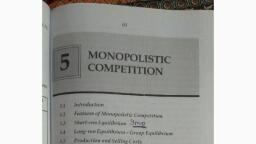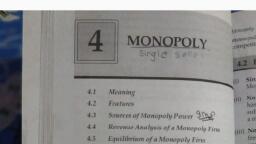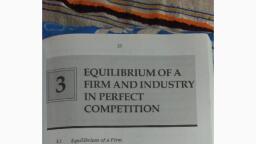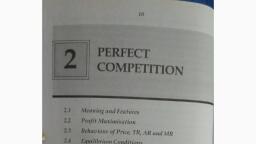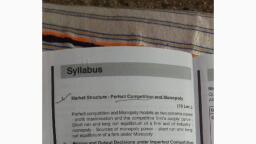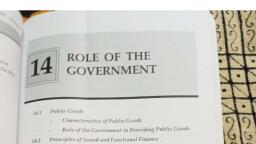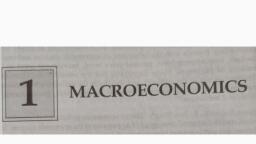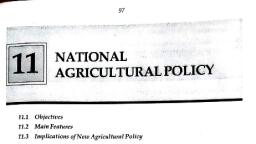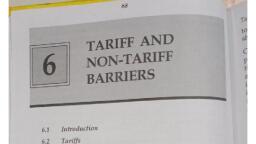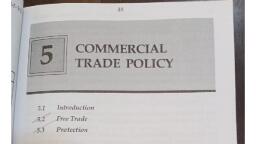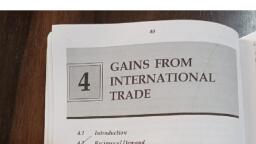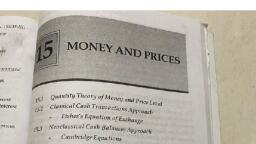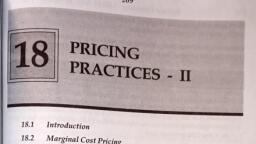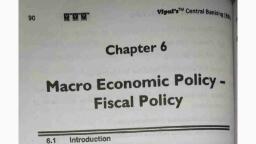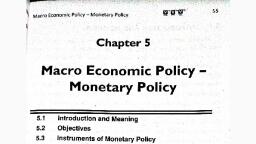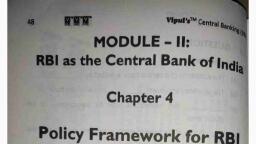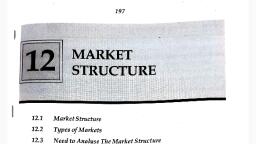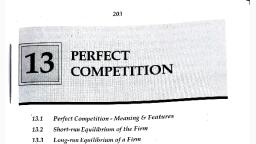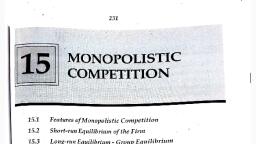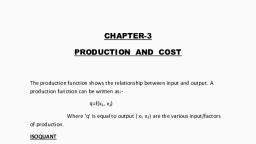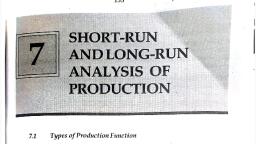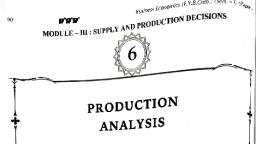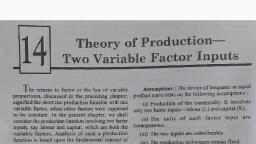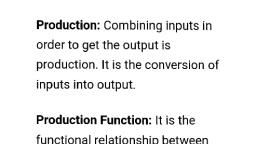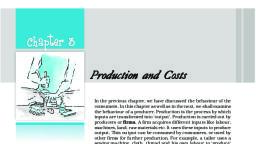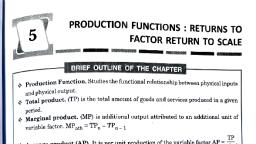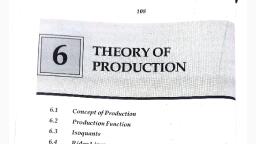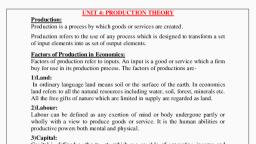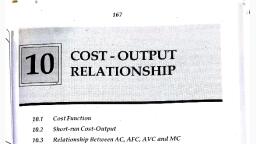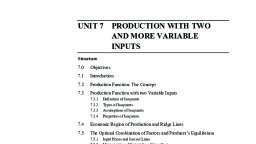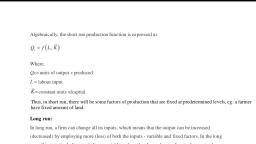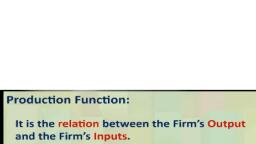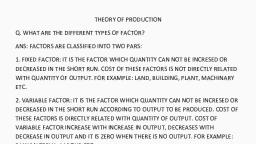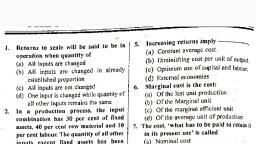Page 1 :
ftvv t, , , , , , 7.1 Types of Production Function, 7.2 Law of Variable Proportions, 7.3 Laws of Returns to Scale, , , , Fixed Proportion and Variable Proportion, Production Function, , , , Production function is of two different forms: fixed proportion, production function and variable proportion production function., , Fixed Proportion Production Function, , A fixed proportion production function is one in which the technology, requires a fixed combination of inputs, say capital and labour, to produce, a given level of output. There is only one way in which the factors may be, combined to produce a given level of output efficiently. In this type of, production, there is no possibility of substitution between the factors of, production.
Page 2 :
134 Business Economics - [ (BMS, BAF, BFM, BBL: SEM, ‘|, , Fixed proportion production function is illustrated by isoquants (explai :, in Chapter 6) which are 'L! shaped or 'right angle’ shaped. This is showy {, Fig. 7.1. : i, , Capital, , NY Ww nnn «~, , , , , , Labour, Fig. 7.1, , Let us suppose that at point A;, output is one unit. The isoquant Q, passing, through the point A, shows that one unit of output is produced by using), units of capital and 3 units of labour. In other words, the capital-labow, ratio is 2 : 3. In this case with 2 units of capital, any increase in labow, beyond 3 units will not/increase output and, therefore, labour beyond}, units is redundant. Similarly, with 3 units of labour, any increase in capiti, beyond 2 units is redundant. The kink (angle) point shows the most efficie, combination of factors. The capital labour ratio must be maintained fo, any level of output. The output can be doubled by doubling the quantity ¢, inputs, that is, two units of output can be produced by 4 units of capiti, and 6 units of labour. Thus isoquant Q, passes through the point A). Tk, ray OA describes a production process, that is, a way of combining input, to obtain certain output. The slope of the ray shows the capital-labour rati¢, , Fixed proportion production function is characterized by constant returt, to scale, that is, a proportionate increase in inputs leads to a proportions, increase in output. This type of production function provides the basis!", the input - output analysis in economics. Thus, this type of isoquant is al”, called input-output isoquant or "Leontiff" isoquant after. Leontiff wi, , invented the input-output analysis., , QFAMA ARAVWDS *| WB, , a R704 Ith, , Pr, af
Page 3 :
DO eR te Wty , gon anen, , , , Ra 2 —, , 135, , Short-run and Long-run Analysis of Production, , Variable Proportions Production Function roduction, , t familiar P :, ee produced by severa, , say capital and labour., nite number of ways., mbinations of, , Variable proportions production function is the, function. In this case, a given level of output can, alternative combinations of factors of production, s, It is assumed that the factors can be combined in infin:, The common level of output obtained from alternative co, capital and labour is given by an isoquant Q in Fig. 72s, , The isoquant Q is the locus of efficient points of factor cant, produce a given level of output. The isoquant is Se cel end, convex to the origin. It assumes continuous substitutability “ a escarh, labour over a certain range, beyond which factors cannot subs itu, , other., , <, , Capital, , , , oO Labour, Fig. 7.2, , Short Run and Long Run Production Function, , , , The discussion on production upto now has.ignored the time needed in, the production process. There is need to take into consideration the time, factor in the discussion on production. Thus, in this section we consider, the behaviour of production in the short-run and long-run., , The short run is a period in which the firm can adjust production by _, changing variable factors such as materials and labour but cannot change, fixed factors such as capital., , The factors which can be increased in the short run are called variable, factors, for they can be easily changed ina short period of time. Hence, the, level of production can be increased within the limits of existing plant, capacity during the short run. Thus, the short run production function, shows that in the short run the output can be increased by changing the
Page 4 :
136 _, oI Business Economics - I (BMS, BAF, BFM, BBL. SEy,, variable factors, keepi sy, shoxt Fun The neering the fixed factors constant. In other words, in, s, with a given ma of 'S produced witha given scale of production, that, where the ou tout c Plant. The behaviour of production in the short, ,, an be increased by increasing one variable factor keep; t, , other factors fixed is explained by the Law of Variable Proportions, © *, , ee Tun is a period sufficiently long so that all factors inclugj,, cape can be adjusted. Therefore, in the long-run all inputs can ,, adjusted according to the requirement. There is no fixed factor hence 4, inputs are variable, ., , , , The Law of Variable Proportions was developed by classical economists},, explain the behaviour of agricultural output. This law is also known as th,, law of diminishing marginal returns. The law examines the behaviour g, the production in the short-run where the output is increased by increasing, units of variable factors, keeping other factors fixed. This approach specifie;, returns to an individual input., , Paul A. Samuelson states - “An increase in some inputs relative to othe, fixed inputs will, in a given state of technology, cause output to increase, but after a point extra output resulting from the same additions of extra, inputs will become less and less”., , More specifically, this laws states that if, with the given technology,, successive units of an input are added to a constant physical quantity of, another input (or fixed combination of other inputs) the total output, obtained would vary in magnitude through three distinct phases. The, operation of the law is explained below., , This law is based on the following assumptions :, , (i) Fixed Factors : Some factors of production or inputs remain constant, They are called fixed factors. Land in agriculture and capital in, industry are the examples of fixed factors. In this example, let us, assume that land is fixed at 5 acres., , (ii) Variable Factors : These are inputs whose supply can be increased in, the short run and hence called variable factors. Increased production, is possible bya pplying more of variable factors to a given number ot, quantity of fixed factors. Let us assume that labour is the variable |, factor. :
Page 5 :
aoe —— = 2 4A, , 137, , Short-run and Long-run Analysis of Production iable factors are of, , (iti) Homogenity of Variable Factors : All units of vat 1d not change due, , the same efficiency, so that the rate of returns wou., to differences in efficiency., , , , , , , , (iv) State of Technology : Technology is assumed to be given and constant., Table 7.1: Changes in Output due to Increase in Variable Factor, Units of Total Average Marginal, Variable Factor Product Product Product, (LABOUR) (TP) (AP) (MP), , 1 5 5 2, , 2 14 7 9, , 3 30 10 16, , 4 56 14 26, , 5 75 15 19, , 6 90 15 : 15, , 7 98 14 8, , 8 102 12.75 4, , 9 102 11.33 _ 0, , 10 98 3 9.8 -4, , , , , , , , , , , , , , Inthe table 7.1, labour is the variable factor. All other factors are assumed, to be constant. The behaviour of total, average and marginal products as, shown in table 7.1 is explained below : :, , , , ww, , Total Product (TP) : It is the total amount of output produced by all the, variable inputs applied in combination with the fixed input. The total, product increases at an increasing rate upto the 4th unit of labour and, increases at a decreasing rate upto the 8th unit of labour. It reaches, maximum at the 8th unit and remains constant between 8th and 9th units., Thereafter the total product declines., , Average Product (AP) : It is obtained by dividing the total product by the _, , units of total variable factor AP = TP/TVF. The average product continues, , | orise till the 5th unit of labour, remains constant between 5th and 6th, , units of labour and then declines., , Marginal Product (MP) : Marginal product is the additional output, Produced by an additional unit of variable factor. It is equal to a change in, | (otal output divided by a change in total variable factor employed., , ATP, | MP = ——— OR MP=TP,-TP,, , | ATVE, , 1, , —, , v, , ——” =
